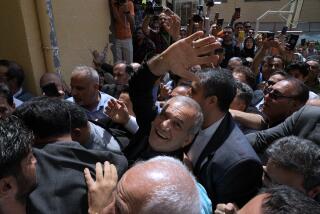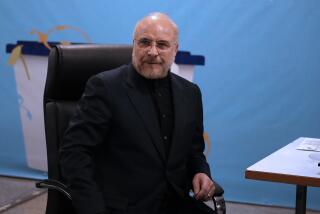Violent clashes erupt between Iranian protesters and security forces
TEHRAN AND BEIRUT — Violent clashes erupted Thursday in downtown Tehran between thousands of defiant protesters chanting “Death to the dictator” and security forces wielding truncheons, as the political crisis over Iran’s disputed presidential election stretched into its fourth week.
Contingents of uniformed and plainclothes security forces flooded the city’s central squares and managed with batons and tear gas to eventually disperse the demonstrators, many of whom wore black and held up their fingers in V-for-victory salutes.
Demonstrators in and around Enghelab (Revolution) Square set fire to trash bins to ward off the effects of the tear gas, witnesses said, but mostly avoided engaging security forces in the rock throwing and running street battles that characterized the protests held just after the June 12 election.
There were reports of clashes in other Iranian cities, but they could not be confirmed.
Demonstrators said they were determined to defy the authorities, led by supreme leader Ayatollah Ali Khamenei, who have demanded an end to rallies and acts of civil disobedience. Tracts distributed online and as leaflets called on protesters to borrow the nonviolent tactics of the U.S. civil rights movement, avoid rifts within their ranks and do nothing that would hamper morale.
Protesters chanted in support of Mir-Hossein Mousavi, who authorities say was defeated by incumbent Mahmoud Ahmadinejad in the presidential vote, and they urged security forces to join them.
“Mojtaba, may you die, so that you don’t get the supreme leadership,” went one chant, referring to Khamenei’s son, who is said to be behind the crackdown and angling for his father’s job.
Though the number of protesters was nowhere close to the hundreds of thousands who took to the streets soon after the election, organizers showed that they could quickly assemble a crowd despite the efforts of security forces.
Thursday was also the anniversary of a student uprising that was violently crushed by the government 10 years ago -- a perennial occasion for confrontations between demonstrators and police.
“It is going to continue,” vowed a marcher in his 60s, big drops of sweat on his forehead. “They have killed our dear youth. How can we forgive them?”
Many of the demonstrators wore surgical masks to conceal their identities from cameras positioned on nearby buildings. They could be seen fleeing into side streets and regrouping as shops were quickly shuttered. Some witnesses said pro-government Basiji militiamen also wore masks, to hide their faces from protesters’ cameras.
Passing drivers and motorcyclists honked their horns and flashed the victory sign in support of the clusters of demonstrators. Business owners could be seen hustling protesters into their buildings to shield them from police. One witness described at least 10,000 demonstrators gathered in one spot, but there was no independent confirmation.
Uniformed security forces on motorcycles and plainclothes officers had blocked off streets around Enghelab Square, near the Tehran University epicenter of the protest. One witness said shots were fired in the air near Vali Asr Square, another downtown crossroads where demonstrators had planned to gather if Enghelab was inaccessible.
As militiamen would try to drag away demonstrators, a witness said, protesters would join together to overpower them. He also said he saw women with their head scarves pulled off being forced into police vans. One woman taking pictures with her cellphone camera was dragged away. One witness said five Basiji militiamen pummeled an elderly lady who loudly warned them that they would receive their comeuppance on Judgment Day.
Police managed to quell the demonstrations within three hours, witnesses said.
“We will wait to see the reflection of today’s event in the local and international media and the responses of the authorities. Then we get together with our fellow demonstrators and decide another contingency plan for further struggles,” said Farzad, a 28-year-old who asked that his last name not be published.
Early in the day, Tehran Gov. Gen. Morteza Tamaddon had vowed that any protest would receive a “crushing” response.
“No request was made for any permit for rallies on Thursday and no permit has been issued,” Tamaddon said, according to the official Islamic Republic News Agency. “The enemies of the Iranian nation are angry with the postelection calm in Iran and try to damage it through their TV channels.”
State television did not mention the unrest.
Speaking to a gathering of provincial governors, whom he appoints, Ahmadinejad described the unrest as a Western attempt to pressure Iran.
“The enemies of Iranians are very angry because despite their propaganda and efforts, a government that has the support of 40 million votes has come to power,” the president said, according to the semiofficial Iranian Students News Agency. “We will not give these oppressive powers any advantage, and they are forced to deal with this government.”
--
Mostaghim is a special correspondent.
More to Read
Sign up for Essential California
The most important California stories and recommendations in your inbox every morning.
You may occasionally receive promotional content from the Los Angeles Times.










